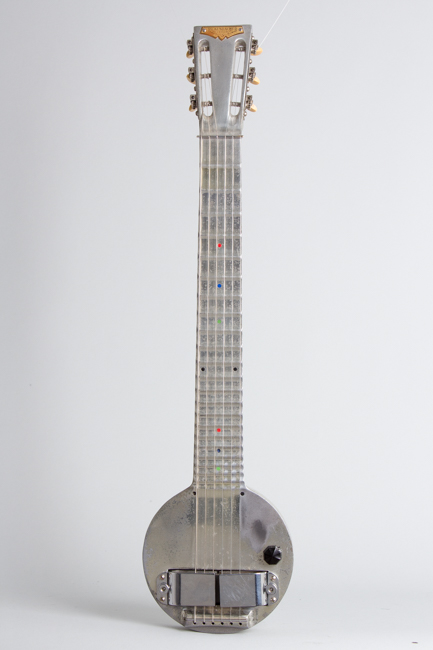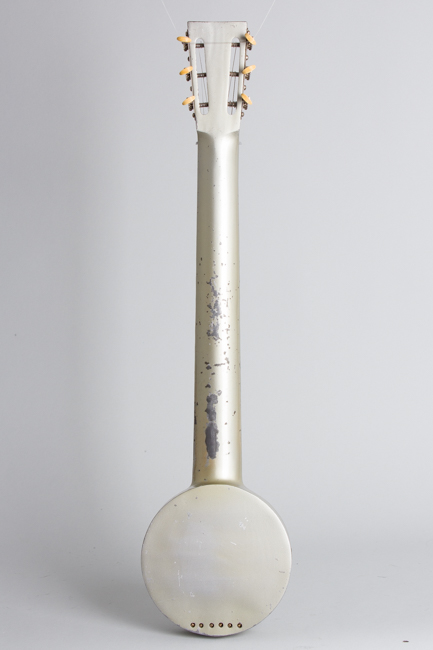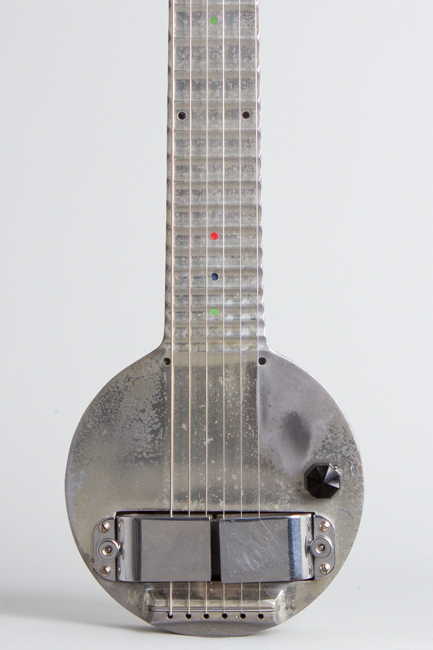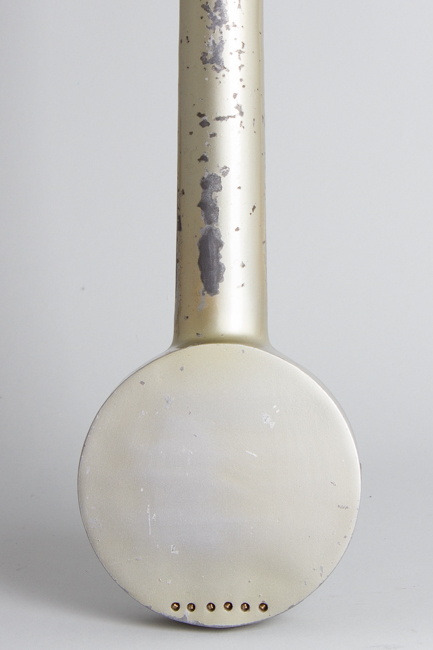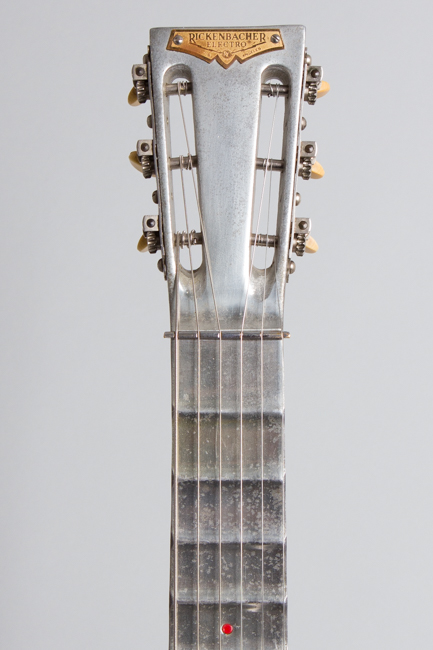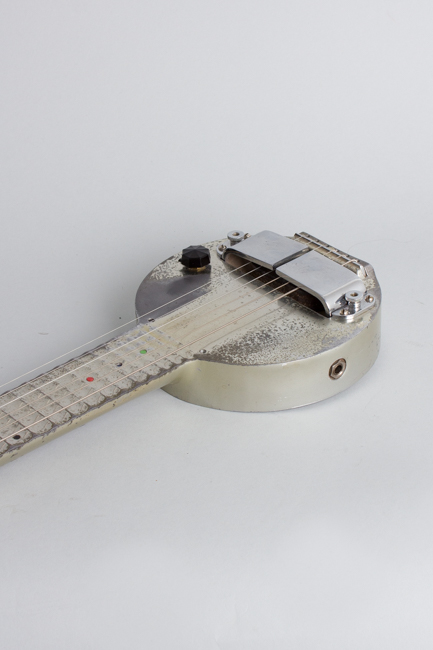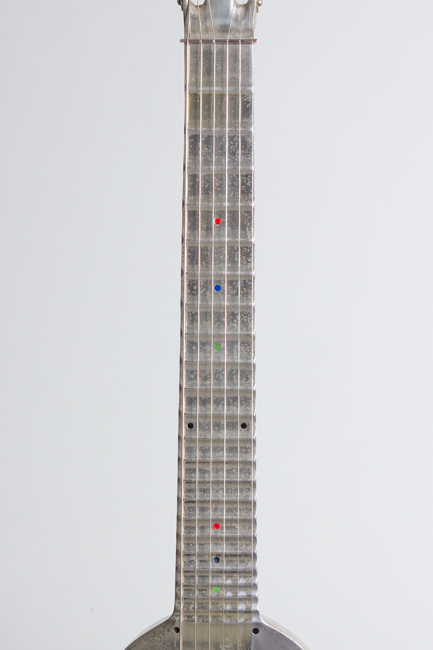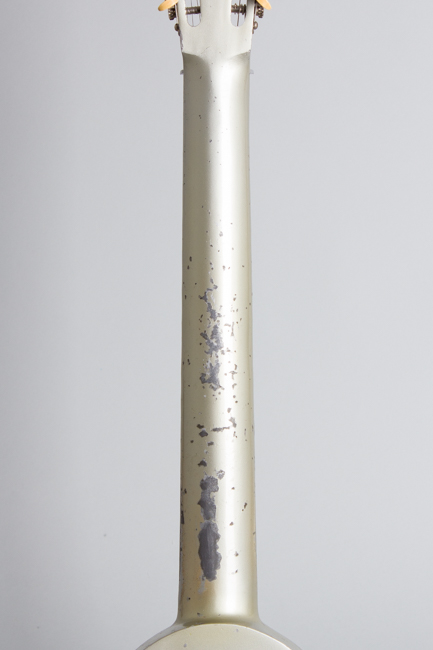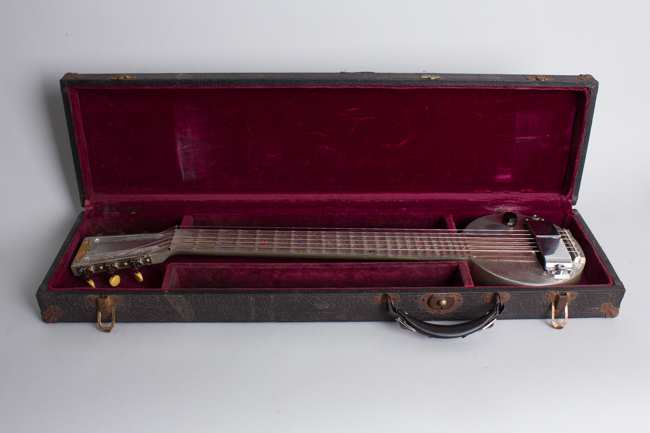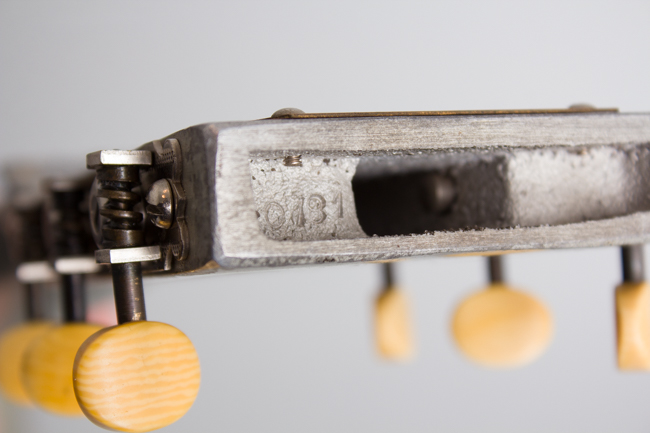Rickenbacker Model A-22 Lap Steel Electric Guitar (1935)
Rickenbacker Model A-22 Model Lap Steel Electric Guitar (1935), made in Los Angeles, serial # 0181, gold enamel and natural aluminum finish, cast aluminum body, original black hard shell case.
The Rickenbacher A-22 Electro Hawaiian Guitar, nicknamed the "Frying Pan" for its distinctive shape is without a doubt one of the most historically important of all 20th century guitars. This was the first commercially successful electrified string instrument as well as the first solid body guitar. It was the initial carrier of the celebrated pre-war 1 1/2 inch horseshoe magnet pickup, the first electro-magnetic instrument pickup to be perfected and still one of the greatest-sounding units ever. While the Rickenbacker company went on to produce many other designs, the "Frying Pan" is where it all began for both this California company and electric guitars in general.
The very first few Rickenbacker Electros from 1932-3 had no onboard controls; these are exceptionally rare. This example is the second major variation with a single volume pot on the treble side of the top. The entire instrument extremely futuristic for the 1930's, a high deco minimalist design fabricated from a single piece of cast aluminum. The fingerboard is integral with the neck with raised ridges for frets and green, red, blue and black inlayed dot markers. Although the A-22 was marketed and almost always used as a Hawaiian guitar, the neck is round-backed and with a different set-up this instrument could have been played Spanish style - something designer George Beauchamp alludes to in the original patent application.
The strings run through the body and over a separate chromed metal saddle, through the horseshoe magnet pickup and on over a chromed brass nut to the slotted headstock. The slotted headstock carries a gold metal name plate reading "Richenbacher Electro, Los Angeles" with "RE" between mirrored lightning bolts. The serial number hand-stamped (rather sloppily) on the top edge of the headstock is 0181 marking this one as built sometime before the later 1935 introduction of the Bakelite Model B. After the Bakelite guitars appeared the A-22 and long-scale companion A-25 were usually stamped with an "A" prefix on the number, although Rickenbacker's Los Angeles factory was rather lackadaisical about this.
Overall length is 28 3/4 in. (73 cm.), 7 in. (17.8 cm.) width, and 1 5/8 in. (4.1 cm.) in depth, measured at side of rim. Scale length is 22 1/4 in. (565 mm.). Width of nut is 2 in. (51 mm.).
Overall this is a nicely preserved example of this rare and sought-after instrument. The only repair is the original pickup coil was rewound and the horseshoe magnets re-charged by Jason Lollar, the pickup guru who made his initial reputation working on these and remains among the very best at this exact art. The pickup sounds truly amazing, bright clear and sweet with a singing character; in its renewed state it is probably as close to the original 1934-5 character as it is possible to get.
The instrument overall shows no serious damage but a decent amount of general wear. The original gold lacquer wash finish on the back and sides shows some light wear; it is heavily chipped on some of the back of the neck.
The top of the "pan" and fingerboard show heavier wear, mostly from play. The face of the body is worn down to the bare metal over the surfaces where players' hands made constant contact, most heavily in front of the volume control The fingerboard has wear mostly along the edges. The top, fingerboard and headstock show some "foxing" spots where moisture has lifted small areas of the finish. The tuners, knob, bridge and saddle remain original.
The amazing and wonderful original rectangular case with the leather handle and purple plush lining is surprisingly well preserved, one of the nicer of these seldom-seen cases we have encountered. Many extant examples of this historic early electric guitar have been heavily worn or modified, usually with altered controls. According to legend at least many were melted down in the 1940's to reclaim valuable aluminum for the war production market. This is a very fine original "Frying Pan", played but not abused and with the now restored pickup working perfectly. It still a delightful instrument to play and hear even aside from its historical value. Overall Excellent - Condition.
The Rickenbacher A-22 Electro Hawaiian Guitar, nicknamed the "Frying Pan" for its distinctive shape is without a doubt one of the most historically important of all 20th century guitars. This was the first commercially successful electrified string instrument as well as the first solid body guitar. It was the initial carrier of the celebrated pre-war 1 1/2 inch horseshoe magnet pickup, the first electro-magnetic instrument pickup to be perfected and still one of the greatest-sounding units ever. While the Rickenbacker company went on to produce many other designs, the "Frying Pan" is where it all began for both this California company and electric guitars in general.
The very first few Rickenbacker Electros from 1932-3 had no onboard controls; these are exceptionally rare. This example is the second major variation with a single volume pot on the treble side of the top. The entire instrument extremely futuristic for the 1930's, a high deco minimalist design fabricated from a single piece of cast aluminum. The fingerboard is integral with the neck with raised ridges for frets and green, red, blue and black inlayed dot markers. Although the A-22 was marketed and almost always used as a Hawaiian guitar, the neck is round-backed and with a different set-up this instrument could have been played Spanish style - something designer George Beauchamp alludes to in the original patent application.
The strings run through the body and over a separate chromed metal saddle, through the horseshoe magnet pickup and on over a chromed brass nut to the slotted headstock. The slotted headstock carries a gold metal name plate reading "Richenbacher Electro, Los Angeles" with "RE" between mirrored lightning bolts. The serial number hand-stamped (rather sloppily) on the top edge of the headstock is 0181 marking this one as built sometime before the later 1935 introduction of the Bakelite Model B. After the Bakelite guitars appeared the A-22 and long-scale companion A-25 were usually stamped with an "A" prefix on the number, although Rickenbacker's Los Angeles factory was rather lackadaisical about this.
Overall length is 28 3/4 in. (73 cm.), 7 in. (17.8 cm.) width, and 1 5/8 in. (4.1 cm.) in depth, measured at side of rim. Scale length is 22 1/4 in. (565 mm.). Width of nut is 2 in. (51 mm.).
Overall this is a nicely preserved example of this rare and sought-after instrument. The only repair is the original pickup coil was rewound and the horseshoe magnets re-charged by Jason Lollar, the pickup guru who made his initial reputation working on these and remains among the very best at this exact art. The pickup sounds truly amazing, bright clear and sweet with a singing character; in its renewed state it is probably as close to the original 1934-5 character as it is possible to get.
The instrument overall shows no serious damage but a decent amount of general wear. The original gold lacquer wash finish on the back and sides shows some light wear; it is heavily chipped on some of the back of the neck.
The top of the "pan" and fingerboard show heavier wear, mostly from play. The face of the body is worn down to the bare metal over the surfaces where players' hands made constant contact, most heavily in front of the volume control The fingerboard has wear mostly along the edges. The top, fingerboard and headstock show some "foxing" spots where moisture has lifted small areas of the finish. The tuners, knob, bridge and saddle remain original.
The amazing and wonderful original rectangular case with the leather handle and purple plush lining is surprisingly well preserved, one of the nicer of these seldom-seen cases we have encountered. Many extant examples of this historic early electric guitar have been heavily worn or modified, usually with altered controls. According to legend at least many were melted down in the 1940's to reclaim valuable aluminum for the war production market. This is a very fine original "Frying Pan", played but not abused and with the now restored pickup working perfectly. It still a delightful instrument to play and hear even aside from its historical value. Overall Excellent - Condition.
